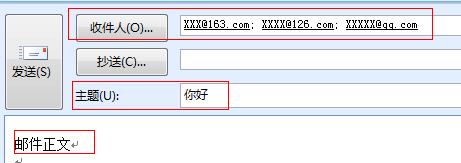python发邮件需要掌握两个模块的用法,smtplib和email,这俩模块是python自带的,只需import即可使用。smtplib模块主要负责发送邮件,email模块主要负责构造邮件。
smtplib模块主要负责发送邮件:是一个发送邮件的动作,连接邮箱服务器,登录邮箱,发送邮件(有发件人,收信人,邮件内容)。
email模块主要负责构造邮件:指的是邮箱页面显示的一些构造,如发件人,收件人,主题,正文,附件等。

1.smtplib模块
smtplib使用较为简单。以下是最基本的语法。
导入及使用方法如下:
import smtplib smtp = smtplib.SMTP() smtp.connect(\'smtp.163.com,25\') smtp.login(username, password) smtp.sendmail(sender, receiver, msg.as_string()) smtp.quit()
说明:
smtplib.SMTP():实例化SMTP()
connect(host,port):
host:指定连接的邮箱服务器。常用邮箱的smtp服务器地址如下:
新浪邮箱:smtp.sina.com,新浪VIP:smtp.vip.sina.com,搜狐邮箱:smtp.sohu.com,126邮箱:smtp.126.com,139邮箱:smtp.139.com,163网易邮箱:smtp.163.com。
port:指定连接服务器的端口号,默认为25.
login(user,password):
user:登录邮箱的用户名。
password:登录邮箱的密码,像笔者用的是网易邮箱,网易邮箱一般是网页版,需要用到客户端密码,需要在网页版的网易邮箱中设置授权码,该授权码即为客户端密码。
sendmail(from_addr,to_addrs,msg,...):
from_addr:邮件发送者地址
to_addrs:邮件接收者地址。字符串列表[\'接收地址1\',\'接收地址2\',\'接收地址3\',...]或\'接收地址\'
msg:发送消息:邮件内容。一般是msg.as_string():as_string()是将msg(MIMEText对象或者MIMEMultipart对象)变为str。
quit():用于结束SMTP会话。
2.email模块
email模块下有mime包,mime英文全称为“Multipurpose Internet Mail Extensions”,即多用途互联网邮件扩展,是目前互联网电子邮件普遍遵循的邮件技术规范。
该mime包下常用的有三个模块:text,image,multpart。
导入方法如下:
from email.mime.multipart import MIMEMultipart from email.mime.text import MIMEText from email.mime.image import MIMEImage
构造一个邮件对象就是一个Message对象,如果构造一个MIMEText对象,就表示一个文本邮件对象,如果构造一个MIMEImage对象,就表示一个作为附件的图片,要把多个对象组合起来,就用MIMEMultipart对象,而MIMEBase可以表示任何对象。它们的继承关系如下:
Message +- MIMEBase +- MIMEMultipart +- MIMENonMultipart +- MIMEMessage +- MIMEText +- MIMEImage
2.1 text说明
邮件发送程序为了防止有些邮件阅读软件不能显示处理HTML格式的数据,通常都会用两类型分别为"text/plain"和"text/html"
构造MIMEText对象时,第一个参数是邮件正文,第二个参数是MIME的subtype,最后一定要用utf-8编码保证多语言兼容性。
2.1.1添加普通文本
text = "Hi!\\nHow are you?\\nHere is the link you wanted:\\nhttp://www.baidu.com" text_plain = MIMEText(text,\'plain\', \'utf-8\')
查看MIMEText属性:可以观察到MIMEText,MIMEImage和MIMEMultipart的属性都一样。
print dir(text_plain)
[\'__contains__\', \'__delitem__\', \'__doc__\', \'__getitem__\', \'__init__\', \'__len__\', \'__module__\', \'__setitem__\', \'__str__\', \'_charset\', \'_default_type\', \'_get_params_preserve\', \'_headers\', \'_payload\', \'_unixfrom\', \'add_header\', \'as_string\', \'attach\', \'defects\', \'del_param\', \'epilogue\', \'get\', \'get_all\', \'get_boundary\', \'get_charset\', \'get_charsets\', \'get_content_charset\', \'get_content_maintype\', \'get_content_subtype\', \'get_content_type\', \'get_default_type\', \'get_filename\', \'get_param\', \'get_params\', \'get_payload\', \'get_unixfrom\', \'has_key\', \'is_multipart\', \'items\', \'keys\', \'preamble\', \'replace_header\', \'set_boundary\', \'set_charset\', \'set_default_type\', \'set_param\', \'set_payload\', \'set_type\', \'set_unixfrom\', \'values\', \'walk\']
2.1.2添加超文本
html = """ <html> <body> <p> Here is the <a href="http://www.baidu.com">link</a> you wanted. </p> </body> </html> """ text_html = MIMEText(html,\'html\', \'utf-8\')
2.1.3添加附件
sendfile=open(r\'D:\\pythontest\\1111.txt\',\'rb\').read() text_att = MIMEText(sendfile, \'base64\', \'utf-8\') text_att["Content-Type"] = \'application/octet-stream\' text_att["Content-Disposition"] = \'attachment; filename="显示的名字.txt"\'
2.2 image说明
添加图片:
sendimagefile=open(r\'D:\\pythontest\\testimage.png\',\'rb\').read() image = MIMEImage(sendimagefile) image.add_header(\'Content-ID\',\'<image1>\')
查看MIMEImage属性:
print dir(image)
[\'__contains__\', \'__delitem__\', \'__doc__\', \'__getitem__\', \'__init__\', \'__len__\', \'__module__\', \'__setitem__\', \'__str__\', \'_charset\', \'_default_type\', \'_get_params_preserve\', \'_headers\', \'_payload\', \'_unixfrom\', \'add_header\', \'as_string\', \'attach\', \'defects\', \'del_param\', \'epilogue\', \'get\', \'get_all\', \'get_boundary\', \'get_charset\', \'get_charsets\', \'get_content_charset\', \'get_content_maintype\', \'get_content_subtype\', \'get_content_type\', \'get_default_type\', \'get_filename\', \'get_param\', \'get_params\', \'get_payload\', \'get_unixfrom\', \'has_key\', \'is_multipart\', \'items\', \'keys\', \'preamble\', \'replace_header\', \'set_boundary\', \'set_charset\', \'set_default_type\', \'set_param\', \'set_payload\', \'set_type\', \'set_unixfrom\', \'values\', \'walk\']
2.3 multpart说明
常见的multipart类型有三种:multipart/alternative, multipart/related和multipart/mixed。
邮件类型为"multipart/alternative"的邮件包括纯文本正文(text/plain)和超文本正文(text/html)。
邮件类型为"multipart/related"的邮件正文中包括图片,声音等内嵌资源。
邮件类型为"multipart/mixed"的邮件包含附件。向上兼容,如果一个邮件有纯文本正文,超文本正文,内嵌资源,附件,则选择mixed类型。
msg = MIMEMultipart(\'mixed\')
我们必须把Subject,From,To,Date添加到MIMEText对象或者MIMEMultipart对象中,邮件中才会显示主题,发件人,收件人,时间(若无时间,就默认一般为当前时间,该值一般不设置)。
msg = MIMEMultipart(\'mixed\') msg[\'Subject\'] = \'Python email test\' msg[\'From\'] = \'XXX@163.com <XXX@163.com>\' msg[\'To\'] = \'XXX@126.com\' msg[\'Date\']=\'2012-3-16\'
查看MIMEMultipart属性:
msg = MIMEMultipart(\'mixed\') print dir(msg)
结果:
[\'__contains__\', \'__delitem__\', \'__doc__\', \'__getitem__\', \'__init__\', \'__len__\', \'__module__\', \'__setitem__\', \'__str__\', \'_charset\', \'_default_type\', \'_get_params_preserve\', \'_headers\', \'_payload\', \'_unixfrom\', \'add_header\', \'as_string\', \'attach\', \'defects\', \'del_param\', \'epilogue\', \'get\', \'get_all\', \'get_boundary\', \'get_charset\', \'get_charsets\', \'get_content_charset\', \'get_content_maintype\', \'get_content_subtype\', \'get_content_type\', \'get_default_type\', \'get_filename\', \'get_param\', \'get_params\', \'get_payload\', \'get_unixfrom\', \'has_key\', \'is_multipart\', \'items\', \'keys\', \'preamble\', \'replace_header\', \'set_boundary\', \'set_charset\', \'set_default_type\', \'set_param\', \'set_payload\', \'set_type\', \'set_unixfrom\', \'values\', \'walk\']
说明:
msg.add_header(_name,_value,**_params):添加邮件头字段。
msg.as_string():是将msg(MIMEText对象或者MIMEMultipart对象)变为str,如果只有一个html超文本正文或者plain普通文本正文的话,一般msg的类型可以是MIMEText;如果是多个的话,就都添加到MIMEMultipart,msg类型就变为MIMEMultipart。
msg.attach(MIMEText对象或MIMEImage对象):将MIMEText对象或MIMEImage对象添加到MIMEMultipart对象中。MIMEMultipart对象代表邮件本身,MIMEText对象或MIMEImage对象代表邮件正文。
以上的构造的文本,超文本,附件,图片都何以添加到MIMEMultipart(\'mixed\')中:
msg.attach(text_plain)
msg.attach(text_html)
msg.attach(text_att)
msg.attach(image)
3.文字,html,图片,附件实现实例
#coding: utf-8 import smtplib from email.mime.multipart import MIMEMultipart from email.mime.text import MIMEText from email.mime.image import MIMEImage from email.header import Header #设置smtplib所需的参数 #下面的发件人,收件人是用于邮件传输的。 smtpserver = \'smtp.163.com\' username = \'XXX@163.com\' password=\'XXX\' sender=\'XXX@163.com\' #receiver=\'XXX@126.com\' #收件人为多个收件人 receiver=[\'XXX@126.com\',\'XXX@126.com\'] subject = \'Python email test\' #通过Header对象编码的文本,包含utf-8编码信息和Base64编码信息。以下中文名测试ok #subject = \'中文标题\' #subject=Header(subject, \'utf-8\').encode() #构造邮件对象MIMEMultipart对象 #下面的主题,发件人,收件人,日期是显示在邮件页面上的。 msg = MIMEMultipart(\'mixed\') msg[\'Subject\'] = subject msg[\'From\'] = \'XXX@163.com <XXX@163.com>\' #msg[\'To\'] = \'XXX@126.com\' #收件人为多个收件人,通过join将列表转换为以;为间隔的字符串 msg[\'To\'] = ";".join(receiver) #msg[\'Date\']=\'2012-3-16\' #构造文字内容 text = "Hi!\\nHow are you?\\nHere is the link you wanted:\\nhttp://www.baidu.com" text_plain = MIMEText(text,\'plain\', \'utf-8\') msg.attach(text_plain) #构造图片链接 sendimagefile=open(r\'D:\\pythontest\\testimage.png\',\'rb\').read() image = MIMEImage(sendimagefile) image.add_header(\'Content-ID\',\'<image1>\') image["Content-Disposition"] = \'attachment; filename="testimage.png"\' msg.attach(image) #构造html #发送正文中的图片:由于包含未被许可的信息,网易邮箱定义为垃圾邮件,报554 DT:SPM :<p><img src="cid:image1"></p> html = """ <html> <head></head> <body> <p>Hi!<br> How are you?<br> Here is the <a href="http://www.baidu.com">link</a> you wanted.<br> </p> </body> </html> """ text_html = MIMEText(html,\'html\', \'utf-8\') text_html["Content-Disposition"] = \'attachment; filename="texthtml.html"\' msg.attach(text_html) #构造附件 sendfile=open(r\'D:\\pythontest\\1111.txt\',\'rb\').read() text_att = MIMEText(sendfile, \'base64\', \'utf-8\') text_att["Content-Type"] = \'application/octet-stream\' #以下附件可以重命名成aaa.txt #text_att["Content-Disposition"] = \'attachment; filename="aaa.txt"\' #另一种实现方式 text_att.add_header(\'Content-Disposition\', \'attachment\', filename=\'aaa.txt\') #以下中文测试不ok #text_att["Content-Disposition"] = u\'attachment; filename="中文附件.txt"\'.decode(\'utf-8\') msg.attach(text_att) #发送邮件 smtp = smtplib.SMTP() smtp.connect(\'smtp.163.com\') #我们用set_debuglevel(1)就可以打印出和SMTP服务器交互的所有信息。 #smtp.set_debuglevel(1) smtp.login(username, password) smtp.sendmail(sender, receiver, msg.as_string()) smtp.quit()
说明:
如果大家对add_header的入参有更多的了解(Content-Disposition,Content-Type,Content-ID),希望告诉我,谢谢。
(尊重笔者的劳动哦,转载请说明出处哦。)